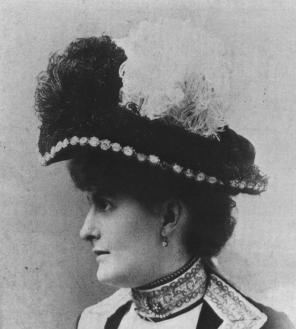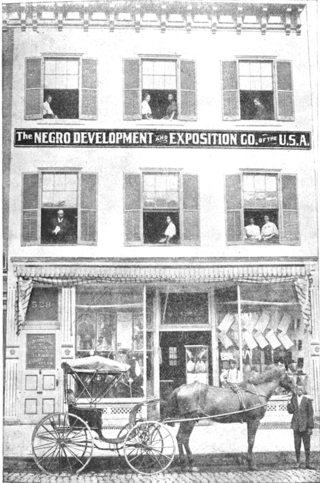A jubilee is a particular anniversary of an event, usually denoting the 25th, 40th, 50th, 60th, and the 70th anniversary. The term is often now used to denote the celebrations associated with the reign of a monarch after a milestone number of years have passed.

A Century of Progress International Exposition, also known as the Chicago World's Fair, was a world's fair held in the city of Chicago, Illinois, United States, from 1933 to 1934. The fair, registered under the Bureau International des Expositions (BIE), celebrated the city's centennial. The theme of the fair was technological innovation, and its motto was "Science Finds, Industry Applies, Man Adapts", trumpeting the message that science and American life were wedded. Its architectural symbol was the Sky Ride, a transporter bridge perpendicular to the shore on which one could ride from one side of the fair to the other.

Juneteenth is a federal holiday in the United States commemorating the end of slavery. Its name is a portmanteau of "June" and "nineteenth", as it is celebrated on the anniversary of June 19, 1865, when in the wake of the American Civil War, Major General Gordon Granger ordered the final enforcement of the Emancipation Proclamation in Texas. Originating in Galveston, Juneteenth has since been observed annually in various parts of the United States, often broadly celebrating African-American culture.

The Sesqui-Centennial International Exposition of 1926 was a world's fair in Philadelphia, Pennsylvania. Its purpose was to celebrate the 150th anniversary of the signing of the United States Declaration of Independence, and the 50th anniversary of the 1876 Centennial Exposition.
A golden jubilee marks a 50th anniversary. It variously is applied to people, events, and nations.

The Tennessee Centennial and International Exposition was an exposition held in Nashville from May 1 – October 31, 1897 in what is now Centennial Park. A year late, it celebrated the 100th anniversary of Tennessee's entry into the union in 1796. President William McKinley officially opened the event from the White House, where he pressed a button that started the machinery building at the fair; he would visit in person a month later.

The Texas Centennial Exposition was a world's fair presented from June 6 to November 29, 1936, at Fair Park, Dallas, Texas. A celebration of the 100th anniversary of Texas's independence from Mexico in 1836, it also celebrated Texas and Western American culture. More than 50 buildings were constructed for the exposition, and many remain today as notable examples of Art Deco architecture. Attracting more than six million people including US President Franklin Roosevelt, the exposition was credited with buffering Dallas from the Great Depression.

The Panama–Pacific International Exposition was a world's fair held in San Francisco, California, United States, from February 20 to December 4, 1915. Its stated purpose was to celebrate the completion of the Panama Canal, but it was widely seen in the city as an opportunity to showcase its recovery from the 1906 earthquake. The fair was constructed on a 636 acre(1 sq. mi., 2.6 km2) site along the northern shore, between the Presidio and Fort Mason, now known as the Marina District.

Chicago Coliseum was the name applied to three large indoor arenas, which stood at various times in Chicago, Illinois, from the 1860s to 1982. They served as venues for large national conventions, exhibition halls, sports events, and entertainment.
Black History Month is an annual observance originating in the United States, where it is also known as African-American History Month. It has received official recognition from governments in the United States and Canada, and more recently has been observed in Ireland and the United Kingdom. It began as a way of remembering important people and events in the history of the African diaspora. It is celebrated in February in the United States and Canada, while in Ireland and the United Kingdom it is observed in October.

Emancipation Day is observed in many former European colonies in the Caribbean and areas of the United States on various dates to commemorate the emancipation of slaves of African descent.
The Association for the Study of African American Life and History (ASALH) is a learned society dedicated to the study and appreciation of African-American History. The association was founded in Chicago on September 9, 1915, during the National Half Century Exposition and Lincoln Jubilee, as the Association for the Study of Negro Life and History (ASNLH) by Carter G. Woodson, William B. Hartgrove, George Cleveland Hall, Alexander L. Jackson, and James E. Stamps, and incorporated in Washington, D.C., on October 2, 1915. The association is based in Washington, D.C. In 1973, ASNLH was renamed the Association for the Study of Afro-American Life and History.
Fraternal Day is a legal holiday in the state of Alabama in the United States. It is celebrated annually on the second Monday in October on the same day as Columbus Day and American Indian Heritage Day.

Susan Lawrence Dana was an American philanthropist and heiress to a substantial fortune, including silver mines in the Rocky Mountains. After her father died, Lawrence Dana took over his western mines and properties throughout central Illinois. She was also a leading philanthropic figure in Illinois - she held fundraisers or parties for Springfield charities, including the King’s Daughters Home for Aged Women, the Home for the Friendless and several others. She also commissioned Frank Lloyd Wright to create a library for the Lawrence Education Center, named after her father.
George Heriot DeReef was an American lawyer, political candidate, civil rights leader, and businessman in Milwaukee, Wisconsin. He was president of the Milwaukee chapter of the NAACP.

The American Negro Exposition, also known as the Black World's Fair and the Diamond Jubilee Exposition, was a world's fair held in Chicago from July until September in 1940, to celebrate the 75th anniversary of the end of slavery in the United States at the conclusion of the Civil War in 1865.

The Golden Jubilee of Margrethe II was celebrated in 2022 in the Kingdom of Denmark, being the 50th anniversary of the accession of Queen Margrethe II on 14 January 1972.

The Negro Development and Exposition Company of the United States of America, was an organization established in 1903 by Giles Beecher Jackson. It was also known as the Negro Development and Exposition Co. (NDEC), and the Negro Development and Exposition Company of the U.S.A.. It was headquartered at 528 Broad Street in the Jackson Ward neighborhood of Richmond, Virginia, the initial purpose of the company was to support an exhibit dedicated to African Americans in the "Negro Building" at the 1907 Jamestown Exposition. There were public issues with financials and accounting by the NDEC, and in 1908, they were faced with a breach of contract lawsuit related to the 1907 Jamestown Exposition.
















